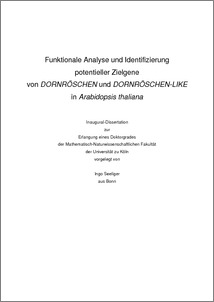Seeliger, Ingo
(2013).
Funktionale Analyse und Identifizierung potentieller Zielgene
von DORNRÖSCHEN und DORNRÖSCHEN-LIKE in Arabidopsis thaliana.
PhD thesis, Universität zu Köln.

![[img]](https://kups.ub.uni-koeln.de/style/images/fileicons/application_pdf.png)  Preview |
|
PDF
Doktorarbeit_Ingo_Seeliger.pdf
- Published Version
Download (3MB)
|
Abstract
Die beiden AP2 Transkriptionsfaktoren DORNRÖSCHEN (DRN) und DORNRÖSCHEN-LIKE (DRNL) kontrollieren redundant die Embryonalentwicklung und die Organogenese am Sproßapex. Die epidermisspezifische Überexpression von DRN oder DRNL unter Kontrolle des ATML1 Promotors erzeugt Zellteilungen und Hyperplasien in epidermalen Zellen des Hypokotyls sowie Musterbildungsdefekte in Form von Stomataclustern in der Epidermis von Kotyledonen und Blättern.
Expressionsanalysen und Kreuzungen mit Mutanten von Schlüsselregulatoren der Stomatazelllinie zeigten, dass diese Phänotypen unabhängig von der Funktion dieser Gene sind und DRN und DRNL eine stimulierende Wirkung auf den Zellzyklus besitzen.
Messungen des DNA-Gehaltes von epidermalen Zellen des Hypokotyls ließen darauf schließen, dass DRN und DRNL, abhängig von Differenzierungsstatus der Zellen, sowohl Zellteilungen als auch Endoreplikation fördern können. Dies deutete darauf hin, dass DRN und DRNL den G1/S-Übergang des Zellzyklus positiv beeinflussen. Differentiell exprimierte Gene aus Transkriptomanalysen transgener ATML1::DRN/DRNL Linien bestätigten diese Annahme, indem sie eine Schnittmenge mit differentiell exprimierten Genen aus Transkriptomanalysen aufwiesen, die im Rahmen zu Studien des G1/S Übergangs durchgeführt wurden. Diese Ergebnisse ließen auf eine Funktion für DRN und DRNL im Meristem schließen, bei der sie in kleinen Populationen von Zellen zusätzliches Teilungspotential erzeugen, welches für das Auswachsen von Organen nötig ist.
| Item Type: |
Thesis
(PhD thesis)
|
| Translated abstract: |
| Abstract | Language |
|---|
| The two AP2 transcription factors DORNRÖSCHEN (DRN) and DORNRÖSCHEN‑LIKE redundantly control embryogenesis and floral organ development in the shoot apex. The epidermisspecific overexpression of either DRN or DRNL under control of the ATML1 promotor causes extra cell divisions in the epidermis of the hypocotyl and leads to stomatal clustering in cotyledons and leaves.
Expression and mutant analysis revealed that both DRN and DRNL act independently from gene functions of the stomatal lineage and that they have a more general role in cell cycle control. Measurement of DNA content in epidermal hypocotyl cells showed that DRN and DRNL promote both mitotic cell cycles and endocycles indicating that both genes have a role at the G1/S-phase checkpoint.
This suggestion was confirmed by transcriptome analysis of transgenic ATML1 lines, which showed a strong overlap with differentially expressed genes from published transcriptome data performed for cell cycle studies. These results suggest a role for DRN and DRNL in creating additional division potential in a small population of cells, which is necessary for organ outgrowth. | English |
|
| Creators: |
| Creators | Email | ORCID | ORCID Put Code |
|---|
| Seeliger, Ingo | ingo.seeliger@gmx.de | UNSPECIFIED | UNSPECIFIED |
|
| URN: |
urn:nbn:de:hbz:38-60944 |
| Date: |
October 2013 |
| Language: |
German |
| Faculty: |
Faculty of Mathematics and Natural Sciences |
| Divisions: |
Faculty of Mathematics and Natural Sciences > Department of Biology > Institut für Entwicklungsbiologie |
| Subjects: |
Life sciences |
| Uncontrolled Keywords: |
| Keywords | Language |
|---|
| Zellzyklus, Sprossapikalmeristem, SAM, Organogenese | German |
|
| Date of oral exam: |
17 October 2013 |
| Referee: |
| Name | Academic Title |
|---|
| Werr, Dr. Wolfgang | Prof. Dr. |
|
| Refereed: |
Yes |
| URI: |
http://kups.ub.uni-koeln.de/id/eprint/6094 |
Downloads per month over past year
Export
Actions (login required)
 |
View Item |


